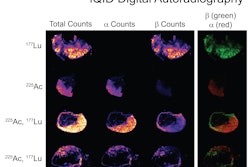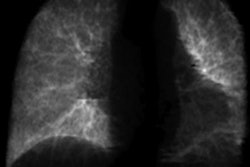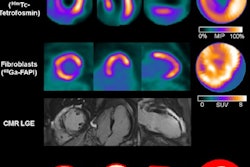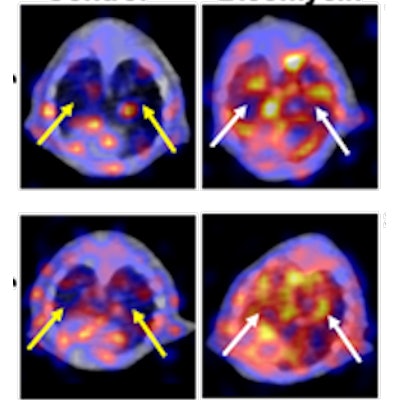
PET imaging with a gallium-68 (Ga-68)-labeled fibroblast activation protein inhibitor (FAPI) shows promise as an effective way to identify and monitor pulmonary fibrosis, according to animal study findings presented at the virtual 2021 Society of Nuclear Medicine and Molecular Imaging (SNMMI) annual meeting.
The technique could add molecular imaging to the lung disease toolbox -- and perhaps reduce the number of biopsies, said study lead author Carolina de Aguiar Ferreira, PhD, of the University of Wisconsin-Madison in a statement released June 12 by the SNMMI.
"Further validation of [PET/CT with gallium-68] for the detection and monitoring of pulmonary fibrosis would make this molecular imaging tool the first technique for early, direct, and noninvasive detection of disease," she said. "It would also provide an opportunity for molecular imaging to reduce the frequency of lung biopsies, which carry their own inherent risks."
Idiopathic pulmonary fibrosis can cause lung scarring that makes breathing difficult, and kills more than 40,000 people each year, the SNMMI said. Unfortunately, a specific diagnostic tool in the form of a biomarker to diagnose and manage the disease has proven elusive. That's why using PET with gallium-68 to target the fibroblast activation protein overexpressed in the disease shows potential.
"CT scans can provide physicians with information on anatomic features and other effects of idiopathic pulmonary fibrosis but not its current state of activity," said lead author Carolina de Aguiar Ferreira, PhD, of the University of Wisconsin-Madison in the statement. "We sought to identify and image a direct noninvasive biomarker for early detection, disease monitoring and accurate assessment of treatment response."
Ferreira and colleagues conducted a study that included 12 mice divided into two groups: one with pulmonary fibrosis (induced with a dose of the cancer drug bleomycin) and a healthy control cohort. Both sets of mice underwent PET/CT scanning with a fibroblast activation protein inhibitor (FAPI)-based radiotracer called Ga-68 FAPI-46. The researchers then measured tracer uptake in the mice's lungs at one hour, seven days, and 14 days after the scan.
The investigators found that CT images showed evidence of fibrosis in those mice injected with bleomycin compared with the control group at all postscan time points (p < 0.05). Compared with control animals, FAPI uptake in the lungs of the mice given bleomycin was twice as high one hour after the exam and three times as high at seven and 14 days.
| FAPI uptake in the lungs of mice with fibrosis and those without | ||
| Time points | Healthy control group | Fibrosis group |
| 1 hour after tracer injection | 0.16 | 0.33 |
| 7 and 14 days after tracer injection | 0.36 | 1.01 |
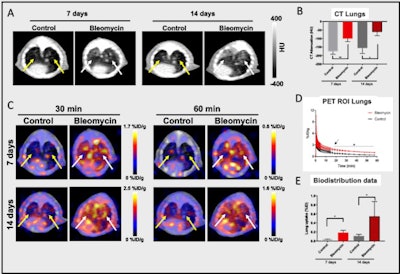 (A) Axial CT images through the mouse lungs at seven and 14 days after intratracheal administration of bleomycin or saline (as a control), demonstrating increased lung fibrosis in the bleomycin group (white arrows). (B) CT attenuation histograms in Hounsfield units (HU) after lung segmentation demonstrate increased attenuation in the lungs in the bleomycin group than the control group (p < 0.05), consistent with increasing fibrosis (n = 3). (C) Representative axial PET/CT fusion images at 20 and 60 min demonstrating increased FAPI uptake in the lungs of the bleomycin group (white arrows) with no significant uptake in the control group (yellow arrows). (D) Time-activity curve of lung uptake ROI analysis demonstrating higher FAPI uptake in the lungs of the bleomycin group than the control (p < 0.05), 14 days after bleomycin (n = 3). (E) Ex vivo biodistribution data of lung tissue demonstrating higher radiotracer uptake in the lungs of the bleomycin group than the control (n = 3). Images and caption courtesy of the SNMMI.
(A) Axial CT images through the mouse lungs at seven and 14 days after intratracheal administration of bleomycin or saline (as a control), demonstrating increased lung fibrosis in the bleomycin group (white arrows). (B) CT attenuation histograms in Hounsfield units (HU) after lung segmentation demonstrate increased attenuation in the lungs in the bleomycin group than the control group (p < 0.05), consistent with increasing fibrosis (n = 3). (C) Representative axial PET/CT fusion images at 20 and 60 min demonstrating increased FAPI uptake in the lungs of the bleomycin group (white arrows) with no significant uptake in the control group (yellow arrows). (D) Time-activity curve of lung uptake ROI analysis demonstrating higher FAPI uptake in the lungs of the bleomycin group than the control (p < 0.05), 14 days after bleomycin (n = 3). (E) Ex vivo biodistribution data of lung tissue demonstrating higher radiotracer uptake in the lungs of the bleomycin group than the control (n = 3). Images and caption courtesy of the SNMMI.Using PET with gallium-68 could offer an effective way to evaluate lung disease, according to the researchers.
"Our results suggest the potential of Ga-68 FAPI-46 PET as a noninvasive tool for early diagnosis and monitoring of pulmonary fibrosis and warrant further exploration of this tool in other translationally relevant models of fibrosis," they concluded.






